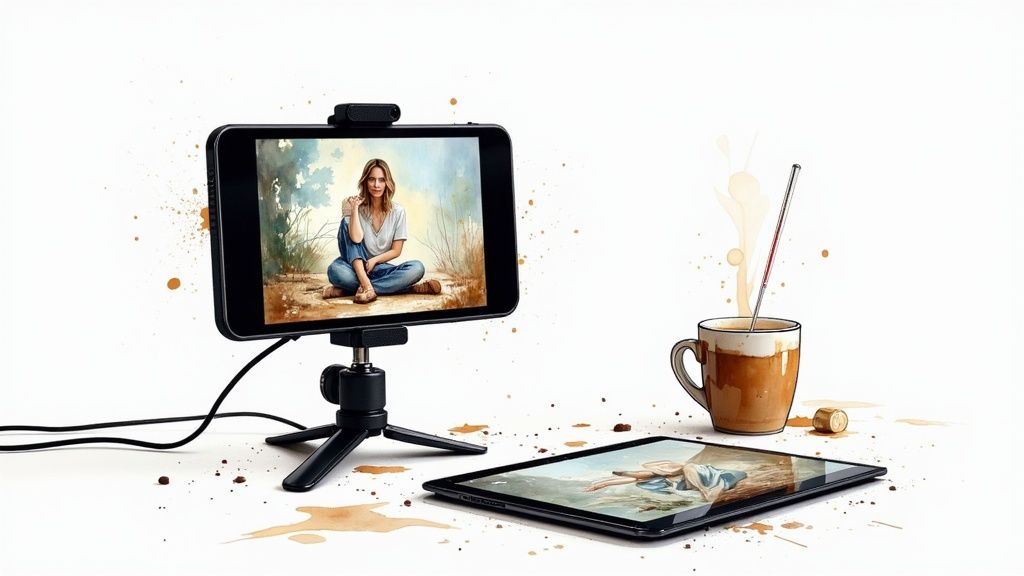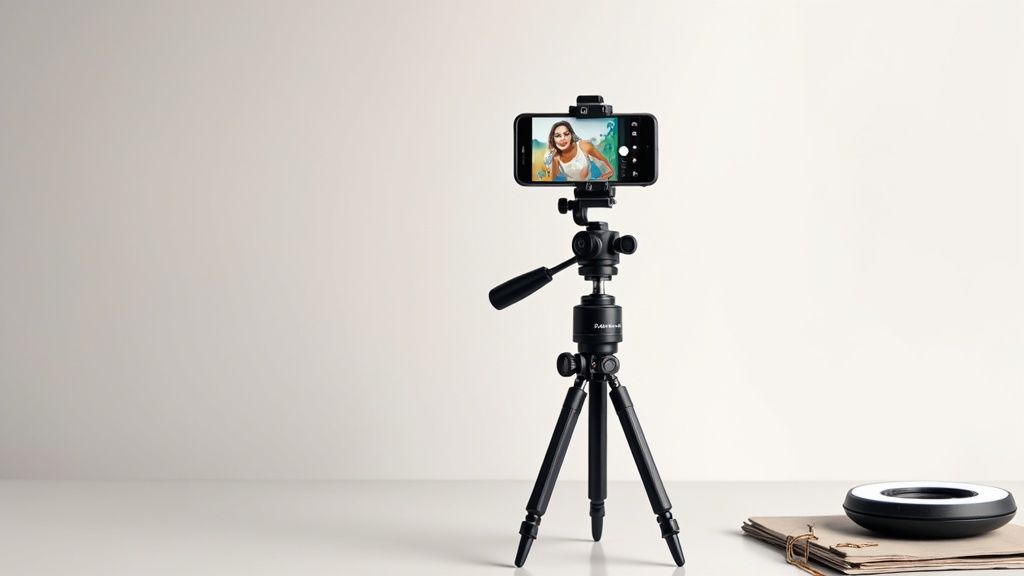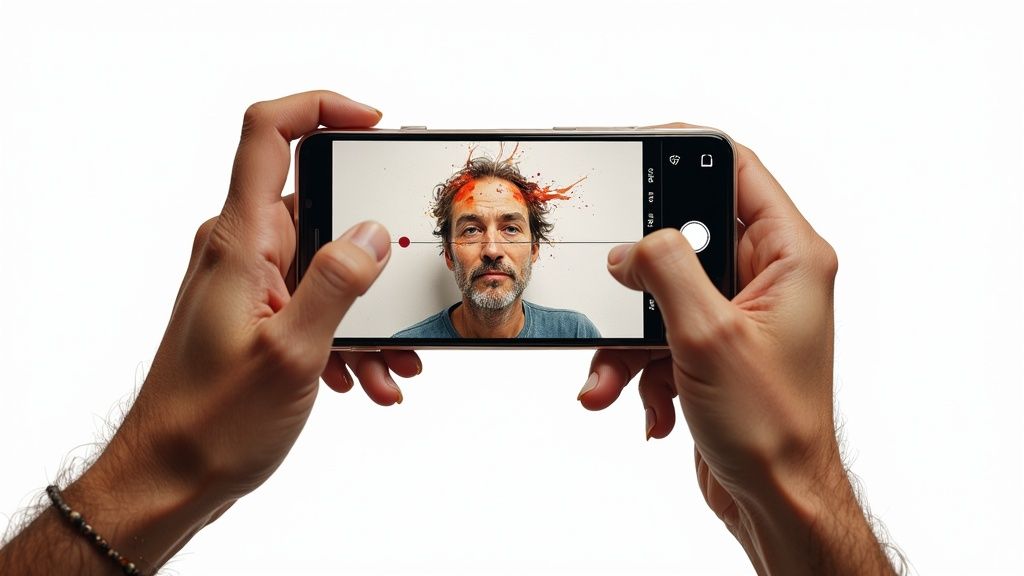Introduction

In today's mobile-first world, short-form video has taken center stage. Consider how much time you spend scrolling through TikTok or Instagram Reels—platforms built on the appeal of short, engaging video content. This growing popularity isn't simply a trend; it represents a real change in how people consume information and connect with brands. This means that knowing how to create these videos is no longer optional, but a vital skill for anyone trying to reach a modern audience.
Why Short Videos Matter
This change has several reasons behind it. First, short videos are easily digestible. They provide information in small, manageable pieces that fit into busy lives and shorter attention spans. Imagine trying to watch a long product demonstration on your commute—a short, punchy video highlighting key features is much more practical. Furthermore, these videos are highly shareable. Their concise format makes them simple to spread across social media, increasing their reach and amplifying your message. For instance, a humorous, relatable video about a common problem your product solves could become incredibly popular, organically reaching thousands of potential customers.
The Power of Mobile Viewing
The prevalence of mobile viewing makes short videos even more critical. Most people watch this type of content on their phones, highlighting the need for brevity. Holding a phone and watching a long video can be awkward; shorter videos make for a much more comfortable viewing experience. This is particularly true when someone is discovering new products or services. A brief, well-made video can quickly show a product's value, grabbing attention and generating interest before viewers lose interest. This also makes them ideal for social media ads, where capturing attention in the first few seconds is paramount.
Getting Started with Creating Short Videos
So, how can you utilize this powerful format? Creating effective short videos involves understanding several key principles, from planning and filming to editing and sharing. By mastering these elements, you can create compelling content that connects with your audience, boosts engagement, and ultimately helps you achieve your marketing objectives. In the following sections, we'll look at the essential equipment, planning strategies, and techniques you need to begin creating impressive short videos.
Essential Equipment

Now that we understand the importance of short videos, let's discuss the practical side of creation. The first step is gathering the necessary equipment. While high-end gear can improve production quality, you don’t need to spend a fortune to create engaging content. Many successful creators rely on readily accessible tools. This section will cover the basic equipment needed to start, balancing quality and cost-effectiveness.
Camera Options for Creating Short Videos
The core of any video project is the camera. You likely already own a powerful one: your smartphone. Modern smartphones have excellent cameras, often rivaling dedicated cameras in portability and ease of use. This makes them perfect for capturing quick, spontaneous content. For example, if you're showing a product or offering a behind-the-scenes look at your business, your smartphone is more than sufficient. If you want a more professional aesthetic, consider a dedicated camera. Mirrorless and DSLR cameras offer greater control over settings like aperture and shutter speed, allowing for a more cinematic style. This can be particularly useful for showcasing product details or capturing visually impressive content.
Sound Matters: Microphones for Clear Audio
While visuals are key, clear audio is just as vital. Poor audio quality can immediately diminish the viewing experience. To ensure your message is heard clearly, consider a microphone. A lavalier microphone, which clips onto your clothing, can drastically improve audio quality for a relatively low cost. For videos where you aren’t on camera, a shotgun microphone mounted on your camera can effectively capture audio from a specific direction. This is helpful for interviews or filming in noisy environments.
Lighting Up Your Videos
Lighting plays a vital role in the quality of your videos. Good lighting enhances the subject, sets the mood, and makes videos visually appealing. Natural light is a great option, particularly for outdoor filming. For indoor shoots or situations without sufficient natural light, some basic lighting equipment is beneficial. A simple ring light or softbox can dramatically improve the look of your videos by creating even lighting and reducing harsh shadows. Affordable options are readily available.
Stabilizing Your Shots: Tripods and Gimbals
Stable footage is key for a professional look. Shaky footage can be distracting and appear amateurish. A tripod provides a stable platform for your camera, preventing unwanted movement and ensuring smooth, steady shots. This is particularly important for static shots, interviews, or product demonstrations. If you're filming videos requiring more dynamic movement, a gimbal is an excellent tool. Gimbals use motors to stabilize the camera, creating smooth, fluid movement even while walking or running. This can add a professional touch, making your videos more engaging. With this basic equipment, you’re well-equipped to create high-quality short videos that attract attention and effectively share your message. Remember, compelling short videos rely more on creativity and storytelling than expensive gear. Next, we'll discuss planning strategies to maximize your video's impact.
Planning Your Content
Having the right equipment is only the first step. Just as a chef needs a recipe, you need a plan for your video content. This pre-production phase ensures your videos are engaging, effective, and meet your goals. This section will guide you through the essential planning steps.
Defining Your Audience and Objectives
Before storyboards or scripts, define your target audience and video objectives. Who are you trying to reach, and what message are you trying to communicate? For a product demo, your target audience might be potential customers, with the objective of highlighting the product's features and benefits. For a behind-the-scenes video, your target audience might be existing customers, and your objective might be to build brand loyalty and community. This clarity is vital for creating focused, effective content.
Crafting a Compelling Narrative
Once you’ve identified your audience and objectives, start crafting a narrative. Even short videos benefit from a clear beginning, middle, and end. Consider it a miniature movie: grab the viewer's attention immediately, present your information concisely, and end with a clear message. You could start by highlighting a problem your product solves, demonstrate the solution, and conclude with a call to action. This structured approach keeps viewers engaged and effectively communicates your message.
Storyboarding Your Short Videos
Storyboarding helps you visually map out your video shot by shot. It's like creating a comic book version of your video, allowing you to visualize the narrative flow and plan shots effectively. While this might seem unnecessary for short videos, it can be incredibly helpful for more complex projects. This can involve basic sketches or specialized software. For example, you might sketch a close-up product shot followed by a wider shot showing it in use. This pre-visualization helps ensure smooth transitions and a polished final product.
Scripting for Success: Writing for Short Videos
Even for seemingly simple videos, a script is beneficial. A script keeps you focused and ensures clear, concise delivery. It also helps with timing, keeping your video within the desired length. If you’re aiming for videos under 60 seconds, a script helps distill your message to its essentials. This doesn't mean writing every word; bullet points or an outline often suffice. This structure ensures you cover all key points without rambling.
Choosing the Right Music and Sound Effects
Don't underestimate the impact of audio. Suitable music and sound effects can elevate your videos by creating mood, adding emphasis, and boosting engagement. Upbeat music creates excitement, while calming music can convey trust. Sound effects can add realism and draw attention to specific moments. Just be sure to observe licensing rules when using music or sound effects. With careful planning and attention to these elements, you can create short videos that grab attention and connect with your audience. The next step is bringing your vision to life through effective shooting techniques, which we'll cover in the next section.
Shooting Techniques

A well-defined plan sets the foundation for great videos, but filming brings your vision to life. This is where ideas transform into engaging content. Understanding basic shooting techniques is essential, even with simple equipment. This section explores key techniques to improve your videos and give them a professional touch, regardless of your budget or skill level.
The Rule of Thirds: Creating Visual Harmony
A fundamental principle of visual composition is the rule of thirds. Visualize dividing your frame into a 3x3 grid. The rule suggests placing key subjects along these lines or at their intersections to create balance and visual appeal. Instead of centering your subject, position them slightly off-center along a vertical line. This adds visual interest and naturally draws the viewer's eye. This is crucial for short videos, where you have limited time to grab attention.
Utilizing Different Shot Types
Varying your shots creates dynamism and keeps viewers engaged. Using only wide shots would become monotonous. Different shot types control pacing and emphasize specific details. A wide shot establishes the scene, a close-up highlights emotions or product features, and medium shots offer balance and a more personal connection. This variety prevents viewer fatigue and improves storytelling.
- Wide Shot (WS): Establishes the scene and the subject's relation to their surroundings.
- Medium Shot (MS): Frames the subject from the waist up, often used for interviews or conversations.
- Close-Up (CU): Focuses on a specific detail, like a face or a product feature, to convey emotion or highlight details.
- Extreme Close-Up (ECU): Magnifies a tiny detail for dramatic effect.
Mastering Camera Movement
Controlled camera movements can make your videos look more professional. Consider the difference between shaky handheld footage and smooth, controlled movement. This adds a cinematic quality, but use camera movement strategically. Too much movement can be distracting. Some common movements include:
- Pan: Horizontal camera movement on a fixed axis, useful for showcasing landscapes or following a moving subject.
- Tilt: Vertical camera movement on a fixed axis, used to reveal a subject or show height.
- Zoom: Changing the lens' focal length to bring the subject closer or further away. Use this cautiously.
- Dolly/Tracking: Moving the entire camera towards or away from the subject to create depth and movement.
Lighting and Composition: Enhancing the Visuals
Lighting is crucial for mood and highlighting your subject. Natural light is excellent, but even simple setups can make a big difference. A softbox or reflector can create softer light and reduce harsh shadows, especially indoors or in low light. Consider the composition of your shots: what to include and how to arrange it. Leading lines, negative space, and symmetry enhance visual appeal. Attention to detail elevates amateur videos to a professional level.
Practicing for Perfection: Creating Short Videos
Creating short videos requires practice. Experiment with different techniques and find what works best for you. The more you practice, the more comfortable you'll become, and the better your videos will be. Start with simple projects and gradually increase complexity as you gain confidence. Consistent practice will enable you to create captivating videos that connect with your audience.
Editing Tips

Filming is just the first step. The real transformation occurs during editing, where raw footage becomes a polished story. This doesn't require expensive software or extensive experience. Even with basic tools, learning some key editing techniques can significantly improve your videos and captivate your audience.
Choosing the Right Editing Software
The first step is selecting editing software. Many options cater to various skill levels and budgets. For beginners, free or low-cost mobile apps like InShot or CapCut offer intuitive interfaces and essential editing tools. For more advanced features, desktop software like DaVinci Resolve (free version available) or Adobe Premiere Pro provides greater control over editing, color, and audio. Choose software that suits your specific needs and resources.
The Art of Trimming and Cutting: Creating a Concise Narrative
Trimming and cutting are fundamental editing techniques. This involves removing unnecessary footage, tightening shots, and creating a concise narrative. It's like sculpting—refining raw material to reveal the final form. For example, trim a shot of someone walking to a location to focus on their arrival, keeping the video fast-paced and preventing viewer fatigue, especially for platforms like TikTok or Instagram Reels.
Seamless Transitions: Connecting Your Shots
Transitions link different shots, creating a smooth flow. While simple cuts can be effective, using fades, dissolves, or wipes adds visual interest and enhances storytelling. A fade to black can end a scene, while a dissolve can create a dreamlike effect. Use transitions sparingly and deliberately. Too many transitions can be distracting.
Enhancing Audio: Music, Sound Effects, and Voiceovers
Audio is crucial for a video's overall impact. Carefully chosen music enhances the tone, adding excitement, drama, or humor. Sound effects add realism and draw attention to specific moments. A whoosh sound can accompany a transition, and a chime can highlight a message. For tutorials or explainer videos, a clear voiceover can guide the viewer. Mindful audio use elevates your videos.
Color Correction and Grading: Creating Visual Consistency
Color correction and grading create a consistent, visually appealing look. Color correction adjusts colors for accuracy and balance, like fixing white balance or exposure. Color grading is stylistic, using color to create mood or aesthetic. Warm tones create a cozy feel, while cool tones can be dramatic. Attention to color significantly enhances video quality. For more advanced tips, check out this article: How to master YouTube short video editing.
Text and Graphics: Adding Clarity and Visual Appeal
Text and graphics enhance short videos by adding context, highlighting information, and increasing visual appeal. Text overlays introduce speakers, display titles, or emphasize points. Graphics, like icons or illustrations, clarify complex concepts or add personality. This is especially helpful for social media, where viewers scroll quickly. Clear text and graphics quickly communicate your message. Use these elements thoughtfully to enhance, not overwhelm, the viewing experience.
Conclusion
Creating short videos might initially seem challenging, but remember the core principle: concise, engaging storytelling. Just like a captivating short story, a well-crafted short video can effectively communicate your message and resonate with your audience. Think of each video as a miniature movie with a beginning, middle, and end. This structure, even within a short timeframe, helps maintain viewer engagement and deliver a clear message.
Embracing the Power of Short-Form Video
The popularity of platforms like TikTok and Instagram Reels demonstrates the undeniable power of short-form video. This shift towards concise content emphasizes the importance of quickly capturing attention and delivering value efficiently. Creating short videos is no longer optional but crucial for connecting with today's audiences. A quick product demonstration can be much more effective than a long blog post, particularly for mobile users.
From Idea to Reality: Making Your Vision a Reality
You should now have a solid grasp of how to create short videos, from planning and filming to editing and sharing. The equipment is less important than the story you tell. A smartphone and creativity can produce excellent results. Start with simple projects, experiment, and don't be afraid to make mistakes. Confidence grows with practice.
Aeon: Empowering Publishers to Create Short Videos at Scale
If you're a publisher looking to create short videos efficiently, consider Aeon. This platform streamlines video creation, from text-to-video conversion to social media optimization. Aeon helps you create engaging short videos at scale, without extensive resources or technical expertise. Transform your written content, audio recordings, or existing videos into dynamic short-form videos that capture attention and drive engagement. Visit Aeon today to discover how to utilize short-form video to reach a wider audience and achieve your content marketing goals.